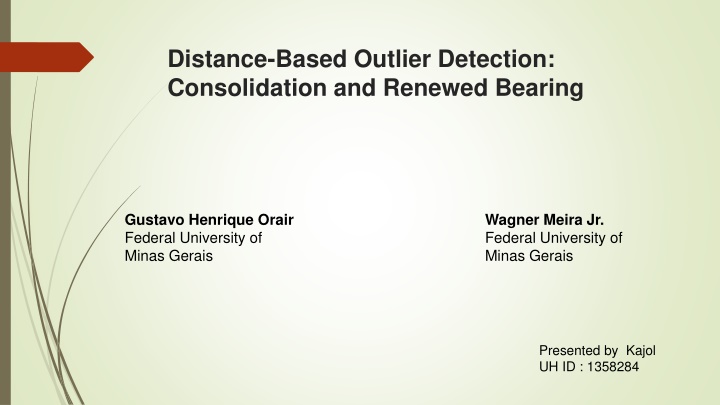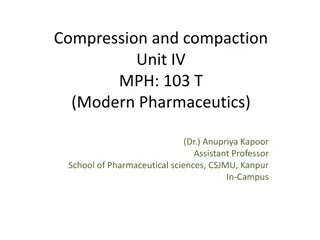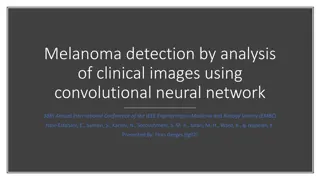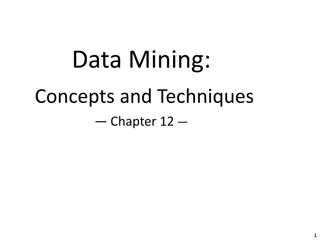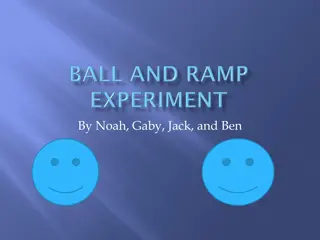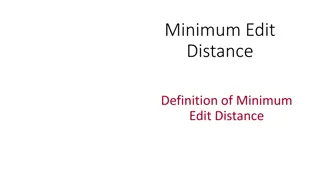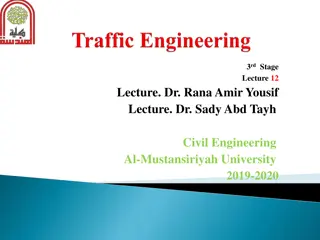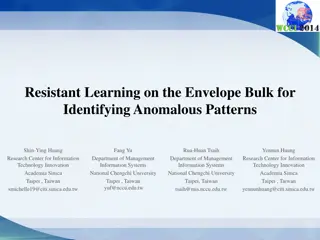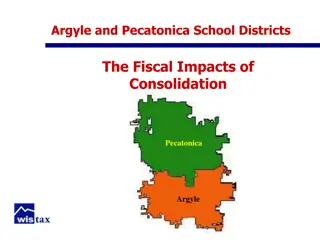Distance-Based Outlier Detection: Consolidation and Renewed Bearing
Outlier detection is crucial in various fields like finance, network security, and healthcare. This paper explores distance-based algorithms for more effective outlier detection. It discusses optimizations and guidelines for designing efficient algorithms through a structured experimental framework on real datasets.
Download Presentation

Please find below an Image/Link to download the presentation.
The content on the website is provided AS IS for your information and personal use only. It may not be sold, licensed, or shared on other websites without obtaining consent from the author.If you encounter any issues during the download, it is possible that the publisher has removed the file from their server.
You are allowed to download the files provided on this website for personal or commercial use, subject to the condition that they are used lawfully. All files are the property of their respective owners.
The content on the website is provided AS IS for your information and personal use only. It may not be sold, licensed, or shared on other websites without obtaining consent from the author.
E N D
Presentation Transcript
Distance-Based Outlier Detection: Consolidation and Renewed Bearing Gustavo Henrique Orair Federal University of Minas Gerais Wagner Meira Jr. Federal University of Minas Gerais Presented by Kajol UH ID : 1358284
PURPOSE OF THE PAPER Distance-Based Outlier Detection has gained attention from 1. Financial fraud analysis 2. Network intrusion applications 3. Clinical diagnosis of diseases. Purpose of the paper is to perform outlier detection more effectively. Several distance-based optimizations have been assessed and evaluated to improve performance, but which optimization is better. What can we learn from the design of the existing algorithms? Can we infer some guidelines for designing better outlier detection algorithms? In this paper Outlier detection framework has been implemented followed by factorial design experiment to understand efficiency gains of various optimizations on real life datasets.
DISTANCE-BASED OUTLIER DETECTION Outlier detections is fundamental step in data quality, data management, and data analysis tasks. We have always been speaking more about Model-Based approach to detect outliers but in such approaches its sometimes hard to determine the underlying data distribution and parameters. In this paper we use Distance-Based Outlier Detection approach, it is defined as : For each object o, examine the other objects in the r-neighborhood of o, where r is a user- specified distance threshold . An object o is an outlier if most of the objects are not in the r- neighborhood of o. These algorithms are : 1. Model Free 2. They rely on distance functions between objects. 3. They rely on approximate nearest neighbor approaches. 4. They scale well to large datasets.
DISTANCE-BASED ALGORITHMS ORCA - Nested Loop algorithm Approximate Nearest Neighbor Search (ANNS) Use partitioning algorithms for preprocessing Pruning partitions when searching neighbors Ranking
NOTATIONS A Glance SYMBOL DESCRIPTION n Number of outliers in result set to be identified in the database k Number of nearest neighbors to be considered Dk(p) Distance between point p and its kth closest neighbor Smallest distance between a point and its kth nearest neighbor from result set Dk min R(P) The MBR diagonal value of a partition P MINDIST Minimum distance between an object and MBR structure MAXDIST Maximum distance between an object and MBR structure
VARIOUS OPTIMIZATIONS APPROXIMATE NEAREST NEIGHBOR SEARCH Important pruning rule defined by Ramaswamy, we may disregard an object p as an outlier, if Dk (p) < Dk min PRUNING Goal is to organize the objects into clusters or partitions so that its not necessary to perform all distance calculations. Indexing data structures has been used as a strategy in various approaches but it suffers the curse of dimensionality.
Clustering based Pruning strategies Pruning Partitions during Search for neighbors (PPSN) Prunes partitions that are far from an object while searching for neighbors. Uses the concept of Minimum Bounding Rectangle (MBR). If MINDIST > Dk (p) , none of the objects in that partition can be among the k-nearest neighbors of p. Pruning Partitions during Search for Outliers (PPSO) Two-phase partition based algorithm, which eliminates whole partitions that do not contain outliers based on the summary statistics generated in clustering phase. It uses bounds , Dkmin lower bound of Dk (p) to prune partitions that do not contain outliers followed by a bound to prune partitions that do not contain kth-NN for points from a partition P.
RANKING It aims to improve the efficiency of ANNS pruning rule ( Dk min > Dk (p)) by increasing Dk min. ANNS depends on order of evaluation of both the objects and their neighbors. Ranking Objects Candidates for Neighbors(ROCN) It ranks the order in which the neighbors of a point are processed, and aims to increase Dk min so that ANNS pruning rule is triggered earlier. ORCA, an algorithm based on nested loops, randomized ranking and ANNS gives near linear time performance even though quadratic in worst case. Ranking Objects Candidates for Outliers(ROCO) Determines which objects are more likely to be outliers and also focuses on increasing Dk min . It uses Bayesian method, Probabilistic Pruning method.
RANKING IN CONJUCTION WITH PARTITIONING ROCN with Partitions RBRP is a two-phase algorithm , first phase is partitioning phase that bins the data space into grid-like partitions. Second phase, uses fast map style of projection of points to rank neighbors. It achieves log-linear performance on average. ROCO with Partitions It is a novel approach in this paper. Summary of each cluster such as number of objects within a cluster, partition volume, density of partition is computed to rank clusters based on their likelihood to contain outliers. Large partitions with low-density regions will increase Dk min and may contain outliers and is likely to achieve better performance overall.
TAXONOMY OF EXISTING WORK Summary of distance-based outlier detection algorithms and strategies
THE DIODE FRAMEWORK Distance-Based Outlier Detection (DIODE) framework is used to perform experiments in isolation or combination, and the strategies employed to improve the effectiveness of the pruning process. It employs a clustering pre-processing step using RBRP-style recursive partitioning and divisive bisection k means clustering algorithm. They can be threshold to a user-defined size( size of partition cannot be more than 16000 points is assumed in this paper).They scale well to large datasets. Preprocessing is followed by ranking strategies, ANNS pruning rule , then factorial design study.
Implementation of Pruning and Ranking using the DIODE framework. 1. PPSO It considers Dk min , which monotonically increases with the execution of the algorithm, once its large enough significant partitions will be pruned. 2. It uses the concept of if MINDIST > Dk (P), a partition P may be discarded. PPSN 3. ROCN Uses same approach as of RBRP 4. ROCO Objects are ranked based on the low density regions as they contain more outliers . Density is estimated by using Density = |P|/R(P) Where |P| - number of objects in partition P R(P) - MBR diagonal length of P
EXPERIMENTAL SETUP AND RESULTS Summary of factorial design study is presented now , it evaluates different pruning and ranking strategies. The average execution time to detect outliers using various strategies on synthetic and real large datasets is measured. Execution time gains are achieved by various optimization strategies. It is shown form the results that the reduction in execution time is observed significantly only when there is an interaction in between various optimizations. Significance of PPSN optimization strategy is also illustrated.
EXPERIMENTAL SETUP Various real and synthetic datasets have been used. Experiments were performed on AMD and top 30 outliers were looked for. ANNS pruning rule and clustering pre-processing is used as a baseline approach
FACTORIAL DESIGN MODEL Experiments have been performed that either enable +1 or disable -1 each of the four factors(strategies). Factorial design model explains impact for each factor and possible interactions of factors on data . It is defined by the equation : Y = Qo + ???? ? where F = { A,B,C,D,AB,AC,AD,BC,BD,CD,ABC,ABD,ACD,BCD,ABCD } Qo = average value from all executions Q = value of factors and interactions on execution time
EXPERIMENTAL RESULTS Average execution times of the outlier detection process for all factor combinations.
EXPERIMENTAL RESULTS Factor values on several datasets
EXPERIMENTAL RESULTS Factor values on several datasets Where, SS - sum of squares due to factor i SS % - Percentage of variation by each factor Q - Execution time gain PPSN, is most effective strategy overall. Only in auction government and Uniform 30D, ROCN is most effective.
CONCLUSION Distance-Based Clustering algorithms have exploited the design space detection algorithms. The paper presented new strategies for ranking and processing outliers. After conducting a full factorial design experiment implemented on DIODE framework certain conclusions have been derived . Firstly, its proved that proposed optimizations are extremely useful for large datasets. Secondly, It can be concluded that effectiveness of any single optimization or combination of optimizations always depends on dataset characteristics.
PERSONAL CONCLUSION The good things about the paper is it presets a different approach to detect outliers. It considers both already proposed distance-based strategies and novel approaches to evaluate the results by giving significant importance to algorithms which get ignored by advance methods. The references mentioned in the paper are too old thereby causing a problem to search more information. Some sections of the paper are really badly presented with improper references.
FUTURE DIRECTIONS AND REFERENCES Better outlier ranking techniques such as Locality Sensitive Hashing scheme can be explored. Still room to look for faster methods to preprocess data and approximate the appropriate bounds of ANNS pruning rule . REFERENCES Gustavo H. Orair, Carlos Teixeira and Wagner Meira Jr., Distance-Based Outlier Detection: Consolidation and Renewed Bearing, Department of Computer Science, UFMG, Brazil E. M. Knorr and R. T. Ng. Finding intentional knowledge of distance- based outliers. In VLDB 99: 25th Int. Conf. on Very Large Data Bases, pages 211 222, San Francisco, CA, USA, 1999. Morgan.
